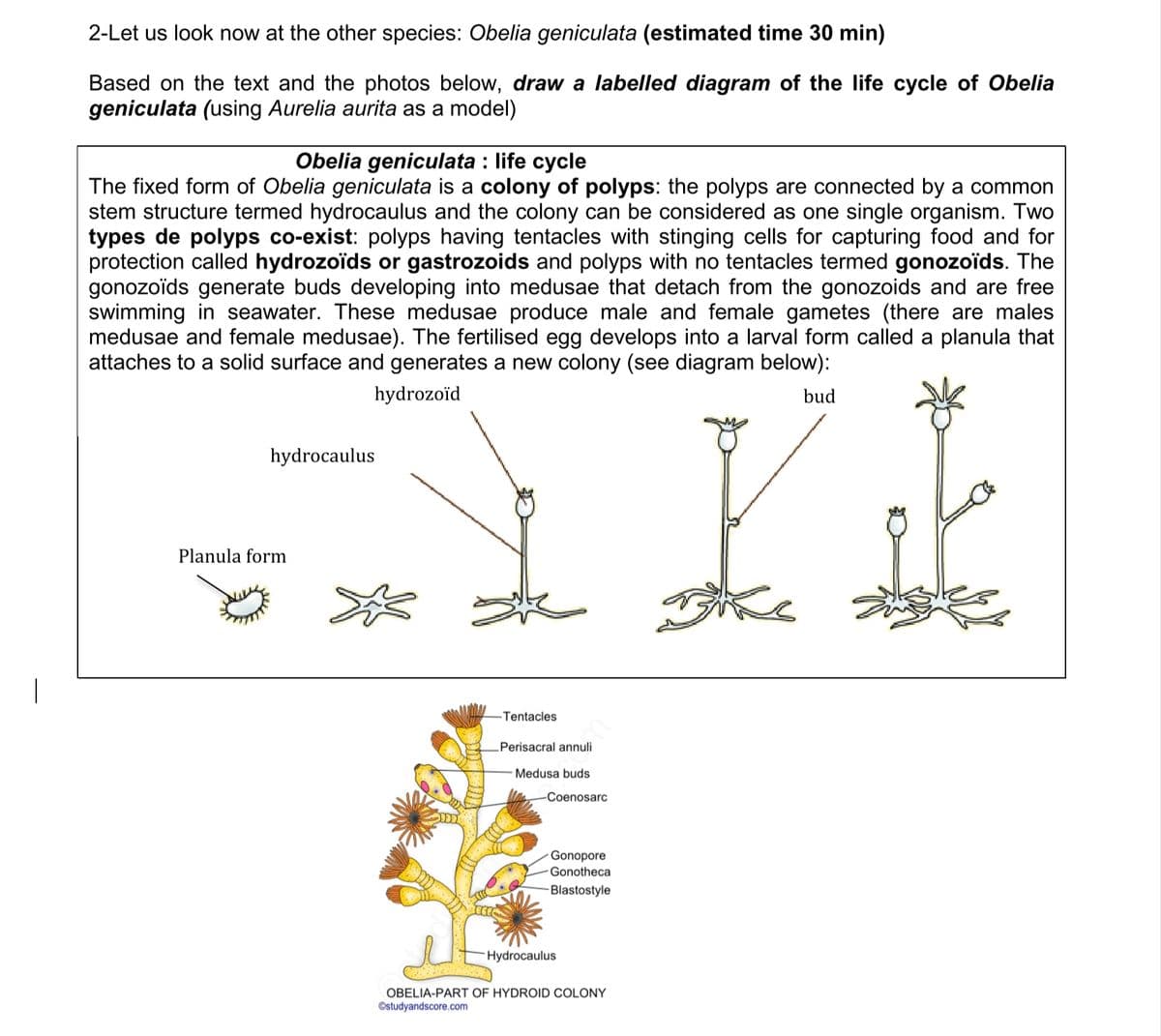Biology: The Dynamic Science (MindTap Course List)
4th Edition
ISBN:9781305389892
Author:Peter J. Russell, Paul E. Hertz, Beverly McMillan
Publisher:Peter J. Russell, Paul E. Hertz, Beverly McMillan
Chapter27: Protists
Section: Chapter Questions
Problem 4TYK: When Paramecium conjugate: a. cytoplasmic division produces four daughter cells, eachhaving two...
Related questions
Question

Transcribed Image Text:2-Let us look now at the other species: Obelia geniculata (estimated time 30 min)
Based on the text and the photos below, draw a labelled diagram of the life cycle of Obelia
geniculata (using Aurelia aurita as a model)
Obelia geniculata : life cycle
The fixed form of Obelia geniculata is a colony of polyps: the polyps are connected by a common
stem structure termed hydrocaulus and the colony can be considered as one single organism. Two
types de polyps co-exist: polyps having tentacles with stinging cells for capturing food and for
protection called hydrozoïds or gastrozoids and polyps with no tentacles termed gonozoïds. The
gonozoïds generate buds developing into medusae that detach from the gonozoids and are free
swimming in seawater. These medusae produce male and female gametes (there are males
medusae and female medusae). The fertilised egg develops into a larval form called a planula that
attaches to a solid surface and generates a new colony (see diagram below):
hydrozoïd
bud
hydrocaulus
Planula form
-Tentacles
Perisacral annuli
Medusa buds
-Coenosarc
Gonopore
Gonotheca
Blastostyle
Hydrocaulus
OBELIA-PART OF HYDROID COLONY
©studyandscore.com
Expert Solution
This question has been solved!
Explore an expertly crafted, step-by-step solution for a thorough understanding of key concepts.
This is a popular solution!
Trending now
This is a popular solution!
Step by step
Solved in 2 steps with 1 images

Knowledge Booster
Learn more about
Need a deep-dive on the concept behind this application? Look no further. Learn more about this topic, biology and related others by exploring similar questions and additional content below.Recommended textbooks for you

Biology: The Dynamic Science (MindTap Course List)
Biology
ISBN:
9781305389892
Author:
Peter J. Russell, Paul E. Hertz, Beverly McMillan
Publisher:
Cengage Learning

Biology: The Unity and Diversity of Life (MindTap…
Biology
ISBN:
9781305073951
Author:
Cecie Starr, Ralph Taggart, Christine Evers, Lisa Starr
Publisher:
Cengage Learning

Biology 2e
Biology
ISBN:
9781947172517
Author:
Matthew Douglas, Jung Choi, Mary Ann Clark
Publisher:
OpenStax

Biology: The Dynamic Science (MindTap Course List)
Biology
ISBN:
9781305389892
Author:
Peter J. Russell, Paul E. Hertz, Beverly McMillan
Publisher:
Cengage Learning

Biology: The Unity and Diversity of Life (MindTap…
Biology
ISBN:
9781305073951
Author:
Cecie Starr, Ralph Taggart, Christine Evers, Lisa Starr
Publisher:
Cengage Learning

Biology 2e
Biology
ISBN:
9781947172517
Author:
Matthew Douglas, Jung Choi, Mary Ann Clark
Publisher:
OpenStax

Biology: The Unity and Diversity of Life (MindTap…
Biology
ISBN:
9781337408332
Author:
Cecie Starr, Ralph Taggart, Christine Evers, Lisa Starr
Publisher:
Cengage Learning